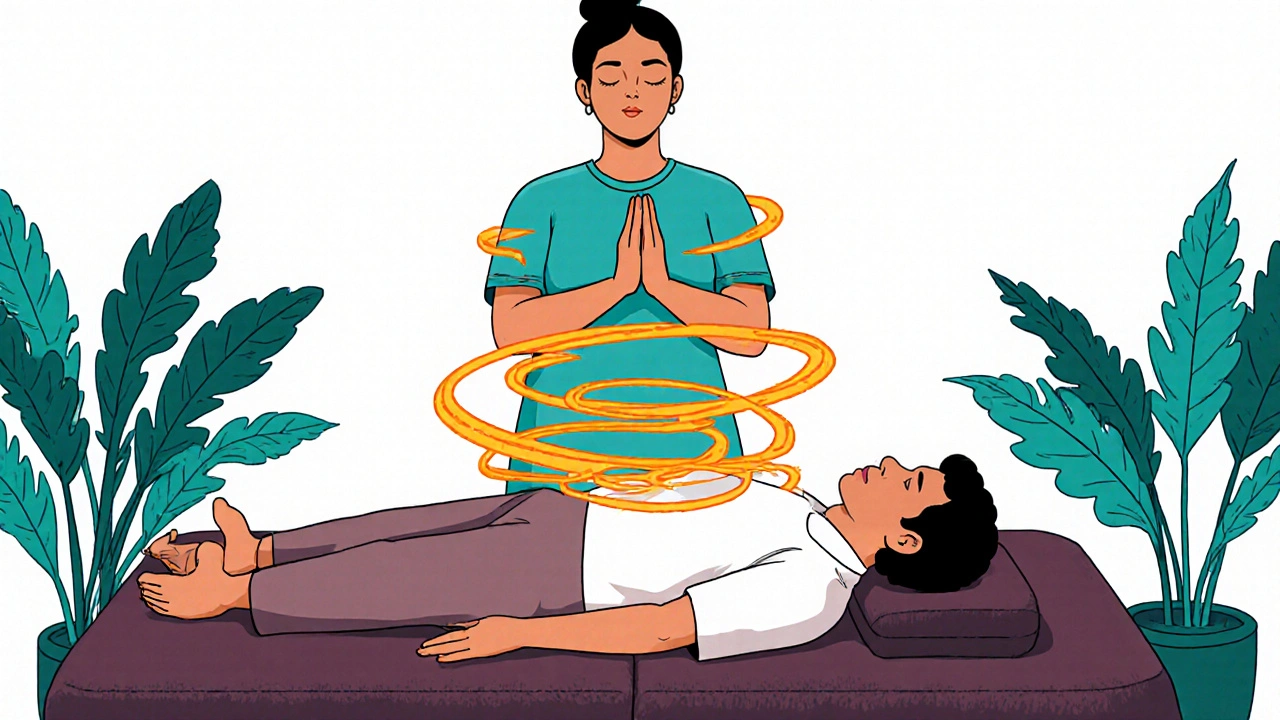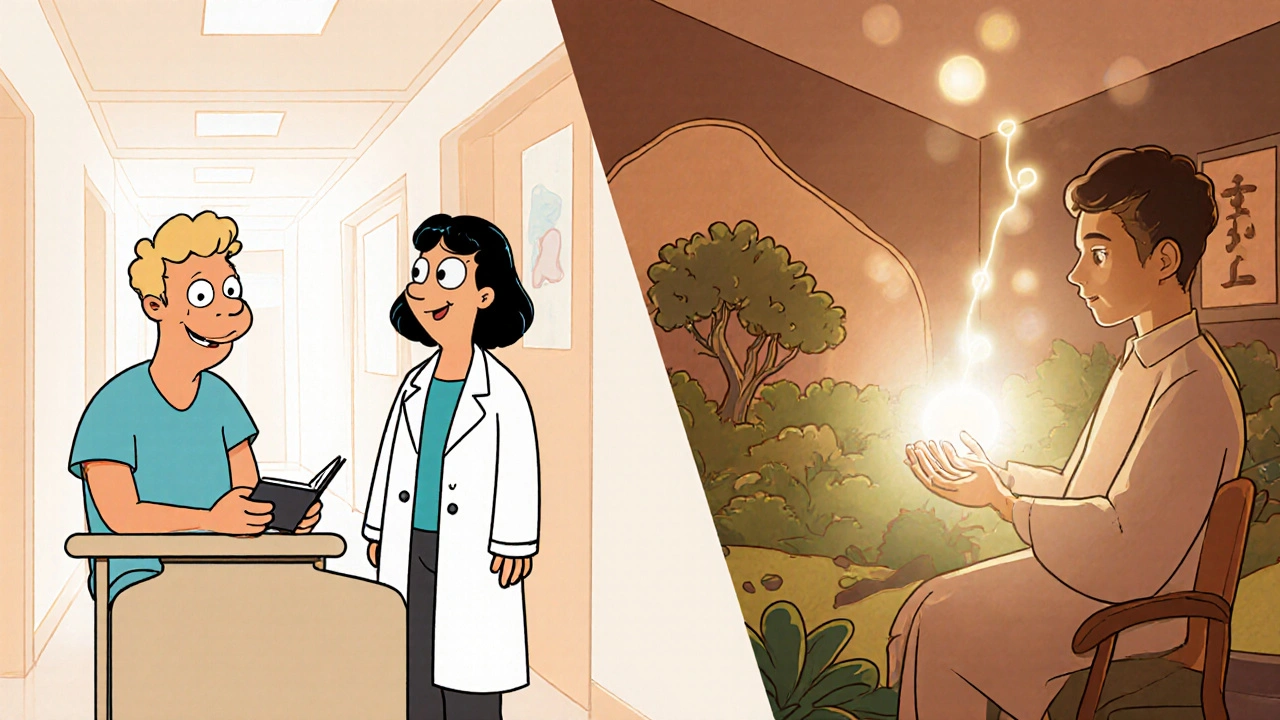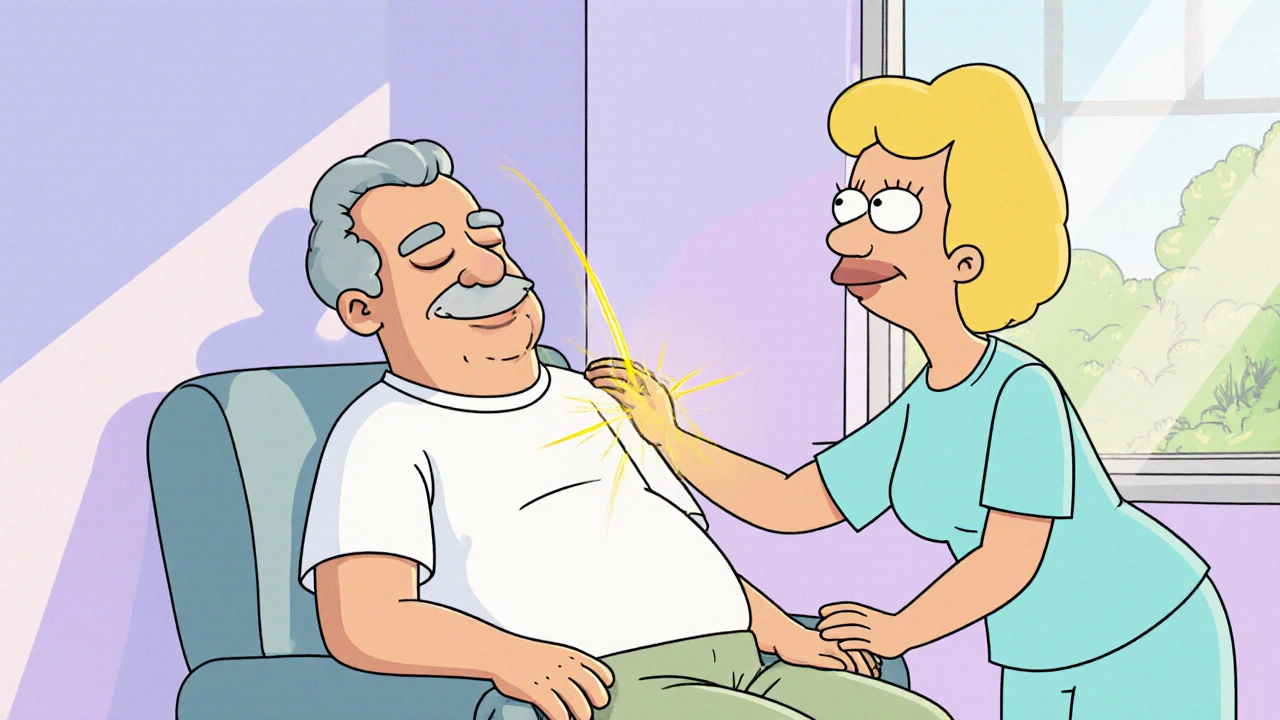Myeloma Symptom Tracker
Symptom Assessment
Rate your current symptoms (0 = no symptoms, 10 = severe symptoms)
Reiki Benefits Estimate
Based on clinical evidence from myeloma studies
Your estimated symptom reduction:
Important Note: Reiki is a complementary therapy that does not replace medical treatment. Benefits vary by individual and are typically modest but meaningful for symptom management.
Imagine sitting in a quiet room, a gentle hand placed on your shoulder, and a warm sensation flowing through you. For many living with myeloma, that simple moment can become a beacon of relief amid chemotherapy, bone pain, and endless doctor visits. While Reiki isn’t a cure, a growing body of patients and clinicians report that energy healing can smooth the rough edges of treatment, improve mood, and even ease physical discomfort. Below we unpack what myeloma is, how Reiki works, and what the evidence says about blending the two.
What Is Myeloma?
Myeloma is a cancer of the plasma cells, a type of white blood cell that lives in bone marrow and produces antibodies. When these cells turn malignant, they crowd out healthy blood‑forming cells, leading to anemia, kidney problems, and weakened bones. According to the International Myeloma Working Group, about 30,000 new cases are diagnosed each year in the United States, and the median age at diagnosis is 70. In the UK, the National Cancer Registry reports roughly 5,000 new cases annually, with a five‑year survival rate hovering around 55% thanks to newer drug regimens.
Standard treatment typically combines chemotherapy, immunomodulatory drugs, and stem‑cell transplantation. While these approaches can extend life, they often bring side‑effects like severe fatigue, neuropathy, and chronic bone pain. That’s where many patients start looking for adjunctive methods to improve quality of life.
Understanding Reiki and Energy Healing
Reiki is a Japanese technique founded in the early 20th century by Mikao Usui. It translates roughly to “universal life energy.” Practitioners claim to channel this energy through their hands, balancing the recipient’s subtle energy fields (often called Qi or prana) to promote relaxation and self‑healing. A typical session lasts 30‑60 minutes, during which the client lies fully clothed while the practitioner places hands on or just above the body in a series of positions.
From a biomedical perspective, Reiki is categorized as a form of energy healing or complementary therapy. It does not involve the insertion of needles, herbs, or medication, making it a low‑risk option for patients already dealing with intensive medical regimens.
How Reiki Might Influence Myeloma Symptoms
- Pain reduction: Several small trials report a modest drop in visual‑analog pain scores after weekly Reiki sessions, likely due to the release of endorphins and the calming of the nervous system.
- Fatigue mitigation: By lowering cortisol levels and encouraging deeper sleep, Reiki can help patients feel more rested, which is especially valuable during cycles of high‑dose chemotherapy.
- Emotional balance: Anxiety and depression are common in myeloma diagnoses. Reiki’s meditative component can activate the parasympathetic response, reducing heart‑rate variability and improving mood.
- Immune modulation: Preliminary laboratory work suggests Reiki may increase natural killer (NK) cell activity, though the clinical relevance for cancer patients remains under investigation.
These benefits do not replace medical treatment but may enhance overall well‑being, making it easier for patients to adhere to their prescribed regimens.

Scientific Evidence and Clinical Studies
Research on Reiki for cancer patients is still emerging, but a handful of studies provide useful clues.
- 2008 randomized trial (USA): 45 breast‑cancer patients receiving standard care were split into Reiki and sham‑Reiki groups. Those who received genuine Reiki reported a 23% reduction in pain scores compared with the control.
- 2014 systematic review (Cochrane): Analyzed 7 trials involving various cancers, including multiple myeloma. The review concluded that while evidence is low‑quality, Reiki appears safe and may have a small positive effect on anxiety and pain.
- 2022 pilot study (UK): Ten myeloma patients underwent 8 weeks of Reiki alongside chemotherapy. Quality‑of‑life questionnaires (EORTC QLQ‑C30) showed statistically significant improvements in fatigue and emotional functioning.
Key take‑aways from the literature:
- Sample sizes are often small, making definitive conclusions difficult.
- Most studies report no adverse events, underscoring Reiki’s safety profile.
- Benefit magnitude tends to be modest but meaningful for patients seeking symptom relief.
Future large‑scale, double‑blind trials are needed, especially ones that focus on myeloma‑specific outcomes like bone‑pain intensity and treatment‑related fatigue.
Practical Tips for Integrating Reiki into Myeloma Care
- Ask your oncologist. Mention your interest in Reiki during appointments. Most cancer centers welcome complementary therapies as long as they don’t interfere with treatment timing.
- Find a qualified practitioner. Look for certifications from recognized bodies such as the International Association of Reiki Practitioners (IARP) or the Reiki Association of the United Kingdom. Verify that the healer has experience working with oncology patients.
- Schedule sessions around treatment cycles. Many patients find it helpful to receive Reiki on days when side‑effects are at their worst-often the day after chemotherapy infusion.
- Set realistic expectations. Reiki is not a painkiller or a substitute for medication. Think of it as a supportive layer that can smooth the edges of discomfort.
- Track your own outcomes. Keep a simple journal noting pain levels, sleep quality, and mood before and after each session. This data can be valuable for your care team.
Remember, Reiki sessions are non‑invasive and can be done in a hospital’s wellness room, a private clinic, or even via distance healing (where the practitioner focuses intent from another location).

Comparing Reiki with Other Complementary Therapies
| Therapy | Primary Mechanism | Typical Session Length | Evidence Strength (Myeloma) | Safety Profile |
|---|---|---|---|---|
| Reiki | Hands‑on energy transfer, promoting relaxation | 30‑60 min | Low‑quality, small‑scale studies | Very low risk, non‑invasive |
| Acupuncture | Needle stimulation of meridians, neural modulation | 20‑45 min | Moderate, some RCTs showing pain relief | Low risk; minor bruising, rare infection |
| Mindfulness‑Based Stress Reduction (MBSR) | Guided meditation and body‑scan techniques | 45‑90 min (group class) plus home practice | Strong, multiple RCTs for fatigue and anxiety | Very low risk, no physical side‑effects |
For patients who prefer a hands‑on, non‑verbal approach, Reiki may be the best fit. Those who enjoy a more active, skill‑based practice might lean toward mindfulness or acupuncture.
Potential Risks and Contraindications
While Reiki is generally safe, a few considerations are worth noting:
- Infection control: Practitioners should wash hands and use clean linens, especially in immunocompromised patients.
- Timing with medication: Some clinics advise a short gap (e.g., 30 minutes) between Reiki and IV chemotherapy to avoid any theoretical interference with drug absorption-though no scientific proof exists.
- Psychological dependence: Relying solely on Reiki for symptom relief without communicating changes to the medical team can delay necessary interventions.
In short, discuss any complementary therapy plan with your oncology nurse or physician to keep the whole care team in sync.
Frequently Asked Questions
Can Reiki cure myeloma?
No. Reiki is a supportive therapy that may improve symptoms like pain and fatigue. It does not target cancer cells or replace standard treatments.
How many Reiki sessions are needed to feel a benefit?
Most studies use weekly sessions for 6‑8 weeks. Some patients notice a calming effect after the first visit, while others need a series to see measurable pain reduction.
Is distance Reiki as effective as in‑person?
Evidence is anecdotal, but many patients report similar relaxation benefits when the practitioner sends intention from afar. It can be a convenient option when travel is difficult.
Will Reiki interfere with my chemotherapy?
No direct interactions have been documented. Still, it’s wise to schedule Reiki at least an hour after infusion to avoid any confusion about side‑effects.
How can I find a reputable Reiki practitioner?
Look for certifications from the International Association of Reiki Practitioners (IARP) or the Reiki Association (UK). Ask your hospital’s integrative oncology team for referrals; they often keep a vetted list.
Integrating Reiki into a myeloma care plan is a personal decision, but the growing pool of patient stories and early research suggests it can be a low‑risk way to boost comfort and emotional well‑being. Talk openly with your care team, try a few sessions, and track how you feel. If the gentle energy of Reiki helps you get through a tough treatment day, that’s a win worth noting.


Benedict Posadas
October 22, 2025 AT 18:20Yo fam, Reiki vibes can be a chill boost during chemoo, give it a try 😊
Kiara Gerardino
October 28, 2025 AT 05:16It's disheartening to see people chase "spiritual shortcuts" while ignoring solid medical science. Reiki might feel nice, but it shouldn't replace evidence‑based treatments. When patients prioritize vague energy concepts over proven therapies, outcomes suffer. We need to keep the focus on real, measurable care.
Tim Blümel
November 2, 2025 AT 17:13While I respect the caution, it's also worth remembering that patient wellbeing is multidimensional. The modest pain reductions reported in small trials likely stem from endorphin release and reduced stress. Integrating a low‑risk practice like Reiki can complement, not replace, conventional regimens. Mind‑body coherence often translates into better adherence to chemo schedules. So, a balanced view is essential.
Emily Collins
November 8, 2025 AT 05:10I once sat in a Reiki session right after a heavy chemo infusion and felt an unexpected wave of calm. It wasn't magical, just a gentle reminder that our bodies can still find moments of peace. Sharing personal anecdotes helps demystify the experience for newcomers.
Don Goodman-Wilson
November 13, 2025 AT 17:06Oh great, another "energy" fix for a disease that kills millions. Sure, let’s all wave our hands and hope the cancer disappears.
Bret Toadabush
November 19, 2025 AT 05:03People don’t tell you that the government and big pharma suppress real energy healing because it threatens their profit margins. The whole "no side effects" line is just a cover for hidden agendas. Stay woke.
Tammy Sinz
November 24, 2025 AT 17:00From a clinical standpoint, the modulation of the autonomic nervous system via Reiki could theoretically influence cytokine profiles. However, current data are insufficient to draw definitive conclusions. Larger, double‑blind studies with standardized dosing are needed to validate any immunomodulatory claims. Until then, label it as an adjunct, not a primary therapy.
Jai Reed
November 30, 2025 AT 04:56Integrating Reiki into a myeloma treatment plan can be approached methodically to maximize potential benefits while maintaining safety. First, discuss the intention to use Reiki with your oncologist; most cancer centers support complementary therapies that do not interfere with pharmacokinetics. Second, seek a practitioner who holds certification from a reputable organization such as the International Association of Reiki Practitioners, ensuring they have experience with oncology patients. Third, schedule Reiki sessions strategically, preferably on days when chemotherapy side‑effects peak, such as the day after infusion, to help mitigate fatigue and pain. Fourth, maintain a simple log tracking pain scores, sleep quality, and mood before and after each session; this quantitative data can be valuable for both you and your care team. Fifth, combine Reiki with other evidence‑based supportive measures like mindfulness‑based stress reduction, which has stronger data for anxiety and fatigue. Sixth, be mindful of infection control: the practitioner should wash hands and use clean linens, especially given immunosuppression. Seventh, consider distance Reiki if travel is challenging; while the evidence is anecdotal, many patients report similar relaxation benefits. Eighth, avoid scheduling Reiki within an hour of intravenous chemotherapy to prevent any confusion about side‑effects. Ninth, set realistic expectations: Reiki is a non‑invasive adjunct that may smooth symptom edges but will not replace chemotherapy or stem‑cell transplantation. Tenth, communicate any changes in symptoms promptly to your medical team; do not rely solely on Reiki for clinical decision‑making. Eleventh, explore insurance coverage or hospital wellness programs that might subsidize session costs. Twelfth, engage in a multidisciplinary discussion involving your oncologist, a palliative care specialist, and the Reiki practitioner to align goals. Thirteenth, respect your own comfort level; if a session feels unhelpful, feel free to discontinue without guilt. Fourteenth, remember that the therapeutic relationship itself-feeling heard and cared for-can contribute to improved quality of life. Finally, keep an open mind but remain grounded in the evidence; the safest path combines conventional treatment with complementary practices that have demonstrated safety and modest efficacy.
Sameer Khan
December 5, 2025 AT 16:53Thank you for the comprehensive outline. From a health‑systems perspective, documenting outcomes in a structured manner facilitates integration of complementary modalities into standard oncology pathways. Moreover, aligning practitioner credentials with institutional policies reduces liability concerns. I would also suggest incorporating patient‑reported outcome measures (PROMs) into the electronic health record to capture the nuanced benefits of Reiki.
Joanne Ponnappa
December 11, 2025 AT 04:50Interesting read! 🌟
Michael Vandiver
December 16, 2025 AT 16:46Thanks for sharing, really helpful! 👍